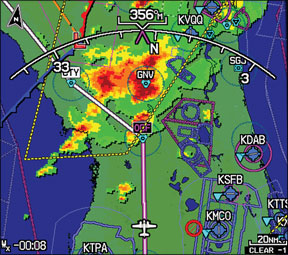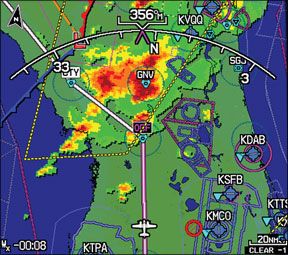I finally got around to catching up on back issues, and came across “Soft Spot” (Editors Log, January 2009), having spent June through September flying from Alaska to and around the lower 48. I relied heavily on my Garmin 496. On August 24, 2008, I had a short leg from Springfield, Mo., to Marion County, Ark. Nexrad showed a line of cells marching across the middle of my flight path. 288 Between the weather briefing and the animated radar, I knew these were moving to the southwest, and I knew the speed of their movement. Space between the cells looked pretty good, so I anticipated I could find a decent path through. Given the technologys delays in displaying radar data on the 496, I chose a path just on the back (upwind) side of one of the displayed cells. I figured it would have moved on from my path and I could get through the gap before the next one arrived. This worked exactly as expected, putting me essentially in the clear area between the two. This meant my flight path headed southeast, instead of almost directly south, from Springfield. The diversion added very little to the flight time, but made the VFR flight very comfortable. With a good understanding of the technical limits of Nexrad on the 496, I made many tactical flying decisions over the four months, decisions which sometimes meant a diversion or delay, but which much more often helped me make the leg without white knuckles. And in almost all cases, I reviewed my decisions against the actual conditions I found, to help me calibrate the information I was getting from the 496. I always follow the 496 with pilotage against sectionals, but my 90 hours of flying would have been much less enjoyable without that wonderful tool. Every issue has something specific in it for me. Thank you. Ken Kokjer, Nexrad in the cockpit is a great tool but, like anything else, has limitations. Anyone who launches into convective weather depending on a Nexrad data stream to stay out of the bad stuff should have a solid-gold Plan B firmly in mind. Remedial Physics 101 In his March 2009 article “Taming Crosswinds,” Rick Durden says, “[Your instructor] reminded you that energy equals mass time (sic) acceleration squared. If you double your speed, you dont double the force of the impact, you quadruple it.” Well, not my instructor. Actually, the kinetic energy of an object equals one-half its mass times the square of its velocity. Force is mass times acceleration. Average acceleration is change of velocity divided by the time over which the change occurs. In an impact where the velocity goes to zero, the change in velocity is equal to the initial velocity, and the time for deceleration is the distance moved divided by the average velocity during deceleration, which is roughly half the initial velocity. Then the average force in an impact is mass times initial velocity squared, divided by twice the distance it takes to stop the object. 288 It is this stopping distance that complicates the calculation of impact forces. This distance depends on many things, including the deformation characteristics of the object. For an airplane plowing nose-first into a solid barrier, the higher its incoming kinetic energy, the more it will deform during the crash and the greater the stopping distance will be. So the impact force is not quite proportional to the square of the velocity. It may be close enough to it for Durdens instructor, but he got to his conclusion by faulty reasoning. William Terry, Like Chevy Chase doing his impersonation of Gerald Ford on Saturday Night Live, we were told there would be no math. Missing Tom Turners article on missed approaches (“The First 400 Feet,” February 2009) provided a lot of useful information and insights. I fly lean-of-peak EGT whenever possible, and have always left my mixture alone until touchdown unless Im executing a missed approach. Based on the article, Im now considering leaning prior to commencing my approach, although this instantly lowers my CHTs significantly-well see. Even with all the good advice in this article, I would like bring into question two of his assertions and get some feedback: 1. That LPV and LNAV/VNAV DA(H)s do not allow for descent below these minimums when executing missed approaches just as in precision ILS or PAR approaches. 2. That the old DH and newer DA(H) having different meanings-that DA(H) for LPV and LNAV/VNAV approaches “represents a hard deck.” I have no argument with the MDA of an LNAV or LNAV+V approach representing a 288 hard deck, just like the MDA for any non-precision approach. First, the term DA(H) is the same term used for ILS, PAR (precision approaches), LPV and LNAV/VNAV (approaches with vertical guidance [AVG). The FAA and Jeppesen seem to be moving towards this ICAO term and away from the old DH, although the older term is still in active use. The names may be different, but the meaning for both the old and newer term remains the same for ILS, PAR, LNAV/VNAV, and LPV: Its the point at which the pilot must decide whether or not to continue the approach or execute the missed approach procedure. If the decision is to be made at that point, during descent on the glideslope, then the same tolerance for going below the DA(H) during the missed approach would seem to have to apply to all of these approaches. (This does not apply to the LNAV+V approach where the glide slope provided is advisory only, and does not guarantee obstacle clearance throughout the approach.) Now, I realize common sense does not always apply when FAA regs are concerned, so I tried to find out where in the FARs and AIM this is discussed, but failed. I then came across a recent article by Ron Levy, a former director of a university aviation program and an FAA Safety Team Representative, where he specifically states that descent below the DA(H) while executing the missed approach from any of the above precision and AVG approaches is acceptable and to be expected. My gut is that Mr. Levy is correct, but Id like some feedback. I fly LPV approaches all the time and if I need to change my missed approach procedure, Id like to know. When experts such as Mr. Turner and Mr. Levy put out conflicting information, it needs to be reconciled. Dan Hammond, Excellent questions deserving greater detail than we have space for this month. Look for an article exploring these and other questions related to WAAS-enabled approaches soon.
Via e-mail
Via e-mail
Via e-mail




